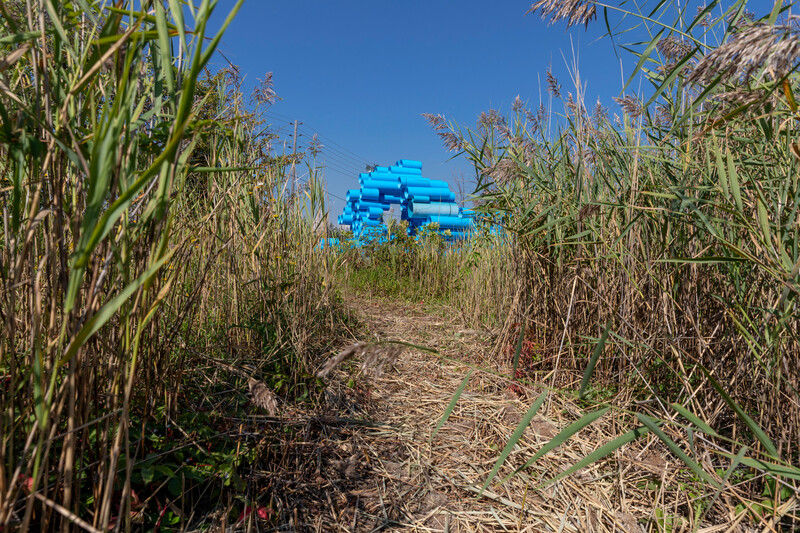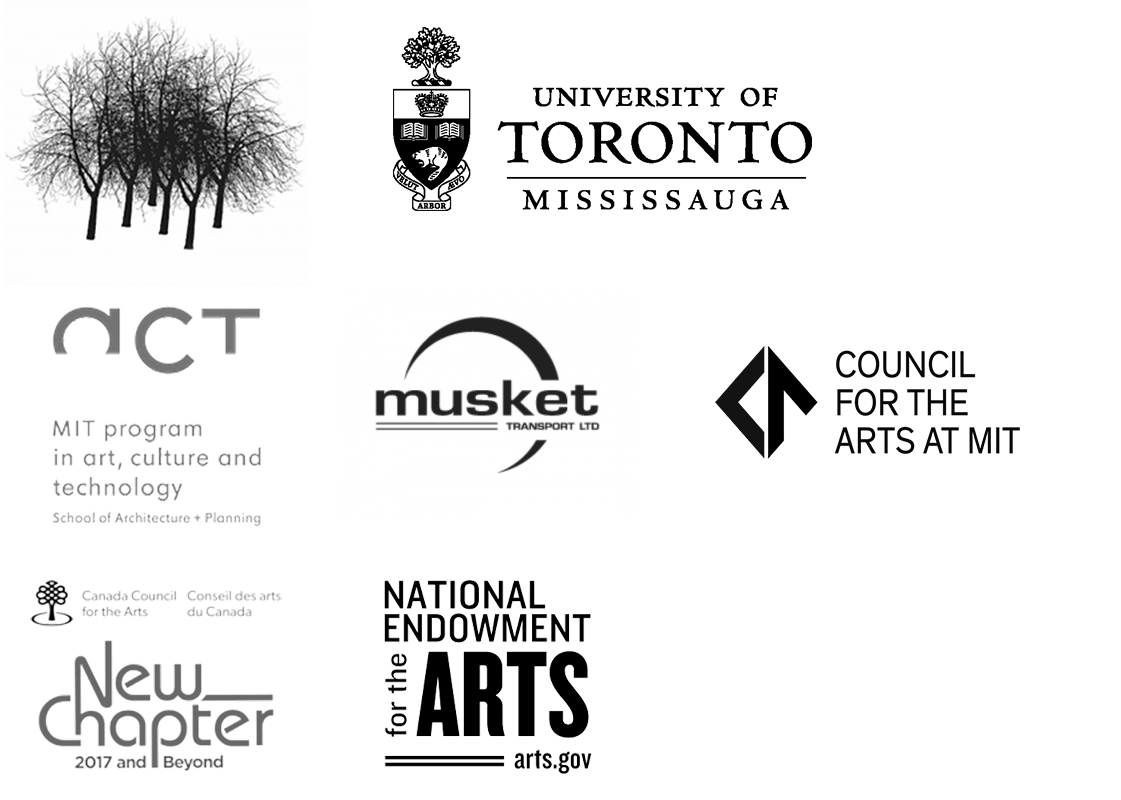
The opening of Futurity Island at MIT will be marked by two days of discursive programming, including performances, talks, and panel discussions. Invited speakers and performers will engage the work’s ecological themes, bringing perspectives informed by Indigenous environmental movements and cosmologies, studies of logistics and infrastructure, design, urbanism, multispecies ecology, and the environmental humanities.
On Sympoietics
Inspired by discussions on radical imagination, Indigenous thought, collective intelligence, and plural ecology, Futurity Island invites participants to develop new habits of thought in this era of environmental crisis. It is a space to speculate on the usefulness of the concept of “sympoiesis” for imaging and working together in radical interdisciplinarity toward desirable futures.
In the utopian regime, the moment of future is transformed into a representable topography of space. Future is a place—an island—a defined location that is better than ours. It is characterized both by separation and distanciation. The geography of a utopian island is manipulatable, as well as conceivable at a glance; it is contained within its limits and is almost transportable as an architectural model or pavilion.
The whole systematicity of the swamp rejects utopian logic, as it cannot be modelled properly within the complexity of symbiotic relationships. Tracing back the dialectics of island and swamp reveals the genesis of radical creativity, creatio ex nihilio, which was described by Cornelius Castoriadis. He conceptualized this process by offering the idea of radical imagination and conceiving it as a generative power, which, preceding every reality, grants a primordial access to materiality.
A swamp is an environment that questions imaginary separation; it is a milieu without solid ground and clear limits. Its lack of complete determination is the source of its power, signalling an urgent need for interdependency. It is an opposite to the geometrical space of a utopian island, which can be dissembled into its constituent parts. Fragmentation, the removal of one element, runs the risk of unbalancing the whole system. Thus, all types of wetlands cannot be thought of as collections of ontogenetic individualities; they exist as constant surplus productions by means of mediation among them.
The radical imaginary of the swamp stems from a critical procedure to question its representations and roles. How can we co-live with the swamp? How can the figure of the swamp dissolve the boundaries of our islands of individuality? How can its sympoietic potential be expanded?
—Gediminas & Nomeda Urbonas, The Swamp School Manual(s)
How to Order
This publication is available for free download. To order any of our publications, please send an email including title(s), number of copies, and your mailing address to: blackwood.gallery[at]utoronto.ca.
- Contributors
- Macarena Gómez-Barris
- Lorena Bello
- Glorianna Davenport
- Erin Genia
- Nicole L’Huillier
- Sadada Jackson
- Caroline A. Jones
- Eben Kirksey
- Tobias Putrih
- Brent D. Ryan
- Indrė Umbrasaitė
- Gediminas & Nomeda Urbonas
Her work addresses artful living and survivance in spaces of social and ecological suffering and include her book The Extractive Zone: Social Ecologies and Decolonial Perspectives. In it, she theorizes decolonization in relation to five extractive scenes of ruinous capitalism upon Indigenous territories (Duke University Press, 2017). She is also author of Beyond the Pink Tide: Art and Political Undercurrents in the Américas (UC Press, August 2018) that thinks from submerged perspectives and art-making, social movements, and creative intellectual labor to imagine worlds anew. Her first book Where Memory Dwells: Culture and State Violence in Chile (UC Press, 2009) traces fascism, the rise of neoliberalism, and memory’s obliteration as central to the nation-state. She shows how memorials, painting, and documentary film production are central to enlivening potential in the ruins of necro-capital. Her co-edited volume with Herman Gray of Toward a Sociology of a Trace (University of Minnesota Press, 2010) addresses global sites of deep cultural imprint, and the invisible work of tethering lives of sustenance after catastrophe. Macarena is working on a new book, At the Sea’s Edge (Duke University Press) that considers the fluidity of colonial transits and the generative space between land and sea.
Macarena is Timothy C. Forbes and Anne S. Harrison University Professor, and Chair of the Department of Modern Culture and Media, as well as faculty member in the Brown Arts Institute.
- Curator
- Christine Shaw
Shaw’s work convenes, enables, and amplifies the transdisciplinary thinking necessary for understanding our current multi-scalar historical moment and co-creating the literacies, skills, and sensibilities required to adapt to the various socio-technical transformations of our contemporary society. She has applied her commitment to compositional strategies, epistemic disobedience, and social ecologies to multi-year curatorial projects including Take Care (2016–2019), an exhibition-led inquiry into care, exploring its heterogeneous and contested meanings, practices, and sites, as well as the political, economic, and technological forces currently shaping care; The Work of Wind: Air, Land, Sea (2015–2023), a variegated series of curatorial and editorial instantiations of the Beaufort Scale of Wind Force exploring the relentless legacies of colonialism and capital excess that undergird contemporary politics of sustainability and climate justice; and OPERA-19: An Assembly Sustaining Dreams of the Otherwise (2021–2029), a decentralized polyvocal drama in four acts taking up asymmetrical planetary crisis, differential citizenship, affective planetary attention disorder, and a strategic composition of worlds. She is the founding editor of The Society for the Diffusion of Useful Knowledge (Blackwood, 2018–ongoing), and co-editor of The Work of Wind: Land (Berlin: K. Verlag, 2018) and The Work of Wind: Sea (Berlin: K. Verlag, 2023).
Matthew Hoffman
Printing
Thistle Printing Ltd.
Funded in part through the Canada Council for the Arts’ New Chapter program. With this $35M investment, the Council supports the creation and sharing of the arts in communities across Canada.
This project is supported in part by an award from the National Endowment for the Arts, the Massachusetts Institute of Technology, the MIT Program in Art, Culture and Technology, the Center for Art, Science & Technology, the School of Architecture and Planning, and IPEX.

Futurity Island
Micropublication produced for the presentation of Futurity Island at the Massachusetts Institute of Technology, September 6–26, 2019. Curated by Christine Shaw.
Co-presented by Blackwood Gallery and MIT Program in Art, Culture and Technology
Free

The Blackwood
University of Toronto Mississauga
3359 Mississauga Road
Mississauga, ON L5L 1C6
[email protected]
(905) 828-3789
The galleries are currently open. Hours of operation: Monday–Saturday, 12–5pm.
Facebook | Twitter | Instagram
Sign up to receive our newsletter.
The Blackwood is situated on the Territory of the Mississaugas of the Credit, Seneca, and Huron-Wendat.